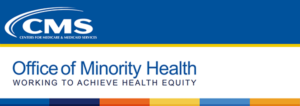January 4, 2023
CMS OMH Recognizes National Poverty in America Awareness Month

National Poverty in America Awareness Month
During January, the Centers for Medicare & Medicaid Services Office of Minority Health (CMS OMH) recognizes National Poverty in America Awareness Month. The United States measures poverty based on how income compares to a federal guide. In 2021, an individual was considered to be living in poverty if their income was lower than $12,880, $26,500 for a family of four. The poverty rate in 2021 was 12.8%, an increase from the 11.4% rate recorded in 2020. American Indian/Alaskan Native individuals were the most impacted (25.9%), followed by Black Americans (21.7%), Hispanic Americans (17.6%), Asian/Native Hawaiian and Pacific Islanders (10.2%), and White Americans (9.5%).
Poverty in the United States is concentrated in specific regions, counties, and neighborhoods. These areas face obstacles such as poor housing and health conditions, higher crime and school dropout rates, lower employment opportunities, and lack of healthy foods, contributing to social determinants of health. Rural poverty rates continue to be higher than urban rates, with Black Americans being the most likely to live in poverty in nonmetro areas. The Southern United States had the highest rural and urban poverty rates (19.7% and 13.8) between 2015 and 2019 while the Northeast had the lowest (12.9% and 12%).
Poverty is shown to influence health outcomes, with unmet social needs, environmental factors, and barriers to accessing health care contributing to worse health outcomes for people with lower incomes. Those who qualify as impoverished may have more difficulty obtaining health insurance or paying for expensive procedures and medications. Children comprise the largest age group experiencing poverty and childhood poverty is associated with developmental delays, toxic stress, chronic illness, and nutritional deficits.
CMS OMH calls for an advancement in health equity for American’s during National Poverty in America Month. Visit the below resources for additional information on how to help during National Poverty in America Awareness Month.
Resources
- Review the CMS Framework for Health Equity 2022–2032 to learn how we’re working to further advance health equity, expand coverage, and improve health outcomes for those supported by CMS programs, including those affected by persistent poverty.
- See the Medicare Savings Program website for Medicare qualifications.
- Details on insulin savings within Medicare can be found here
- Insure Kids Now has an Outreach Tool Library to identify resources to help connect kids to coverage and spread the word about Medicaid and CHIP resources.
- Medicaid has Outreach Tools that provide materials and messages states may use and adapt to support outreach activities.
- Prevention Resources to learn more about preventive services available to adults, teens, children, and infants at no cost.
- See the CDC’s Social Determinants of Health Map for more information on poverty percentages by state.
- Check out the Health People 2030 website to learn more about economic stability’s impact on health.
- Visit the ASPE’s FAQs for poverty guidelines and general poverty.
